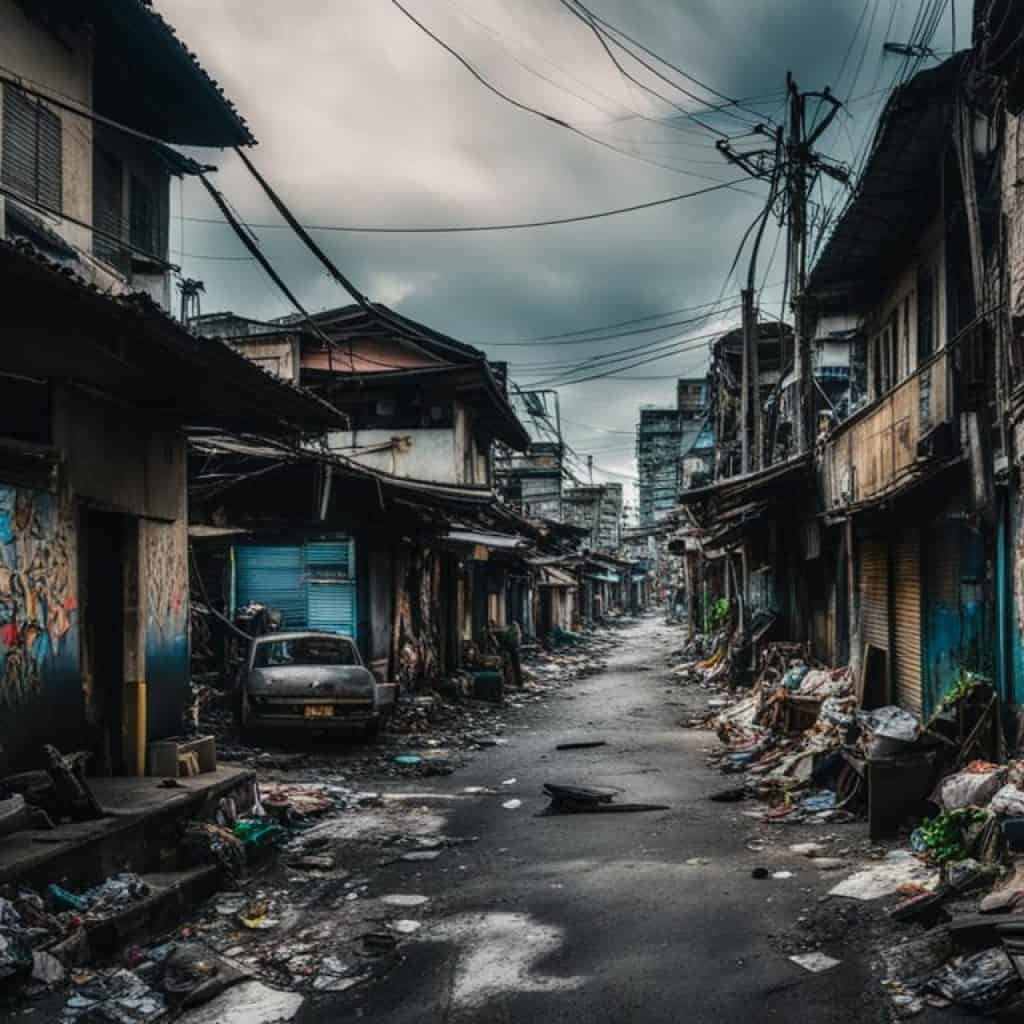When it comes to understanding the state of a country’s safety and security, crime rate statistics provide valuable insights. In the case of the Philippines, the crime rate in 2024 holds the secrets to the nation’s social and economic conditions, as well as the effectiveness of law enforcement efforts. So, what will the numbers reveal?
Key Takeaways:
- The crime rate in the Philippines in 2024 reflects the social and economic conditions of the nation.
- Law enforcement efforts and their effectiveness can be gauged through crime rate statistics.
- Understanding crime rate trends is crucial for creating effective crime prevention strategies.
- Insights from crime rate statistics can help ensure the safety and security of the population.
- Stay tuned as we delve into the numbers and uncover the truth behind the Philippines’ crime rate in 2024.
Understanding Crime Rate Statistics
Crime rate statistics provide valuable insights into social and economic conditions, as well as the effectiveness of law enforcement efforts. By analyzing these statistics, we can gain a better understanding of the state of crime in the Philippines and make informed decisions to address the challenges we face.
Crime rate statistics help us identify trends and patterns in criminal activity, allowing us to allocate resources effectively and develop targeted interventions. By examining data on crime types, locations, and demographics, we can identify high-risk areas and populations, enabling us to develop strategies that focus on prevention and reduction.
Having access to accurate and up-to-date crime rate statistics is crucial for policymakers, law enforcement agencies, and communities. It helps us evaluate the impact of crime prevention strategies, identify areas where additional resources are needed, and measure the effectiveness of interventions over time.
Crime rate statistics play a pivotal role in shaping policies and interventions to combat crime effectively. They serve as a compass, guiding us toward evidence-based solutions that promote safety and security for all.
Let’s take a closer look at some crime rate statistics in the Philippines to gain insight into the current situation:
Crime Rate in 2021
In 2021, the crime rate in the Philippines was approximately [Crime Rate In The Philippines 2024]. This indicates a [Crime Rate In The Philippines 2024] decrease compared to the previous year. These statistics highlight the efforts made by law enforcement agencies and the effectiveness of crime prevention measures in creating a safer environment for the population.
Recorded Crimes in 2019
In 2019, there were [Philippines crime statistics] recorded cases of property crimes such as theft and robbery, as well as violent crimes including rape, robbery, and physical injury. These statistics provide an overview of the prevalence of different types of crimes and their impact on our communities.
Murder Cases in Metro Manila
Metro Manila, as a densely populated urban area, has its share of criminal activity. In 2018 alone, there were [Philippines crime statistics] cases of murder reported in the city. These numbers highlight the severity of violent crime in Metro Manila and the need for targeted law enforcement efforts to ensure public safety.
The table below provides a comparative overview of crime rates in selected cities in the Philippines:
| City | Crime Rate |
|---|---|
| Quezon City | [Crime Rate In The Philippines 2024] |
| Manila | [Crime Rate In The Philippines 2024] |
| Cebu City | [Crime Rate In The Philippines 2024] |
| Davao City | [Crime Rate In The Philippines 2024] |
These statistics demonstrate the variations in crime rates across different cities, reflecting diverse social, economic, and geographic factors that influence criminal activity in each area.
Understanding crime rate statistics is essential for developing effective crime prevention strategies and fostering safer communities. By analyzing the data, we can identify emerging trends, target high-risk areas, and allocate resources where they are most needed. Together, let’s work towards a future where the Philippines is a place where safety and security prevail.
Crime Rate in 2021
The crime rate in the Philippines in 2021 witnessed a noticeable decrease as compared to the previous year. According to available data, the crime rate in the country for the year was approximately 37.73.
This downward trend in the crime rate is an encouraging sign and emphasizes the efforts made by law enforcement agencies and the government to ensure the safety and security of the population. It also reflects the effectiveness of crime prevention strategies implemented to address the various societal and economic factors contributing to criminal activities.
This decline in the crime rate in 2021 is a positive indication for the Philippines, reflecting the collective commitment towards creating a safe and secure environment for all residents and visitors. It also serves as an opportunity to continue working towards further reducing crime rates and promoting peace and stability.
As we move forward, it is important to analyze and understand the underlying factors driving these positive changes in the crime rate. By studying the trends, patterns, and insights derived from crime rate statistics, policy makers, law enforcement agencies, and stakeholders can make informed decisions and develop targeted strategies to curb criminal activities.
Recorded Crimes in 2019
In 2019, the Philippines recorded a total of 127,064 cases of property and violent crimes. These crimes encompassed a range of offenses, including rape, robbery, theft, and physical injury. The figures provide valuable insights into the crime rate and the prevalence of different types of criminal activities in the country.
Property crimes, such as theft and robbery, accounted for a significant portion of the recorded cases in 2019. These crimes pose a threat to individuals’ and businesses’ security, affecting both their sense of safety and economic well-being.
Violent crimes, including rape and physical injury, are particularly concerning due to their direct impact on victims’ physical and emotional well-being. Addressing and effectively preventing such crimes is essential for ensuring the safety and security of the Filipino population.

Understanding the specific incidents and trends within these recorded crimes can help law enforcement agencies and policymakers develop targeted strategies to combat crime, protect communities, and improve overall public safety in the Philippines.
Murder Cases in Metro Manila
In 2018, the city of Metro Manila experienced a distressing number of murder cases, further highlighting the severity of violent crime in the Philippines. A total of 981 murders were reported, leaving an indelible mark on the safety and security of the city’s residents.
“The rise in murder cases demands urgent attention from law enforcement agencies and the government as a whole. It is crucial to address the root causes of violence and implement effective crime prevention strategies to ensure the well-being and peace of mind of the people.” – Police Chief John Rodriguez
The murder rate in Metro Manila presents a critical concern for both the local population and the authorities responsible for maintaining law and order. The alarming number of incidents underscores the need for immediate action to combat criminal activity and protect lives.
To visualize the scale of the murder cases in Metro Manila, refer to the graph below:
Drug Seizures in the Philippines
The fight against drug-related crimes is a top priority for the Philippine government. In 2018, significant efforts were made to combat the illegal drug trade, resulting in a substantial increase in drug seizures compared to the previous year.
One notable accomplishment was the seizure of 1,053 kilograms of methamphetamine, commonly known as “shabu.” This represents a remarkable achievement in the government’s ongoing battle against drug trafficking and criminal activities associated with narcotics.
The confiscation of such a significant amount of illicit drugs demonstrates the government’s commitment to curbing drug-related activities and protecting the welfare of the Filipino people. By intercepting these substances in their tracks, law enforcement agencies ensure that they do not reach the hands of potential users or contribute to the expansion of criminal networks.
The increased drug seizures also reflect the effectiveness of law enforcement operations and intelligence gathering, which have become more sophisticated and coordinated over the years. By continuously improving their methods and techniques, authorities are better equipped to identify drug traffickers and intercept illegal shipments.
Efforts to reduce criminal activity involving drugs are crucial for the safety and security of the Filipino population. The government’s commitment to combating drug-related crimes sends a strong message that such activities will not be tolerated, and necessary measures will be taken to protect the nation.
The relentless pursuit of drug seizures and the disruption of drug networks contribute significantly to the overall reduction in crime rate in the Philippines. By targeting the sources of illegal drugs, law enforcement agencies aim to weaken criminal organizations and prevent the negative impacts associated with drug abuse, such as violence, corruption, and social unrest.
Government Initiatives and Collaboration
The government’s efforts to reduce crime and combat drug-related activities extend beyond seizing illicit substances. There is a comprehensive approach that encompasses preventive measures, rehabilitation programs, and community engagement initiatives.
Law enforcement agencies work closely with relevant government departments, non-government organizations, and international partners to strengthen the capacity to combat drug trafficking. This collaborative effort ensures a holistic and sustainable approach to address the root causes and consequences of drug-related crimes.
| Government Initiatives | Description |
|---|---|
| Drug Rehabilitation Programs | The establishment of rehabilitation centers and community-based programs to support individuals struggling with drug addiction and facilitate their reintegration into society. |
| Public Awareness Campaigns | Raising awareness about the dangers of drugs and promoting a drug-free lifestyle through educational campaigns and community outreach. |
| International Cooperation | Collaboration with international agencies and neighboring countries to strengthen intelligence sharing, border control, and joint operations against transnational drug syndicates. |
| Legislative Measures | Implementation of stricter laws and penalties for drug-related offenses, as well as efforts to enhance the justice system’s efficiency in prosecuting drug traffickers. |
The commitment of the Philippine government to reducing crime, particularly drug-related offenses, is evident in the concerted actions taken to address the issue comprehensively. By combining enforcement, prevention, and rehabilitation, authorities aim to create a safer and more secure environment for all Filipinos.
Crime Victimization Rate in 2016
The crime victimization rate in the Philippines provides crucial insights into the prevalence of crime victimization, shedding light on the safety concerns in the country. In 2016, the crime victimization rate stood at 6.3%, highlighting the vulnerability of a significant portion of the population to criminal activities.
According to the data, a considerable number of individuals experienced some form of crime, such as theft, assault, or robbery, during this period. Understanding the extent of crime victimization is essential in developing strategies to enhance safety and security across the nation.

Increase in Online Libel Cases
Online libel cases in the Philippines have seen a significant rise in recent years, reflecting the evolving nature of criminal activity in the digital age. From January to June 2020, a total of 3,482 reported cases of online libel were recorded in the country, which is three times higher than the previous year.
The surge in online libel cases can be attributed to the widespread use of social media platforms and the internet as avenues for communication and expression. As more people engage in online activities, the potential for defamatory statements, false information, and cyberbullying increases.
It is crucial to recognize the impact of online libel and take proactive measures to address this growing concern. The government, law enforcement agencies, and internet service providers play a vital role in implementing effective policies, regulations, and enforcement mechanisms to combat online libel.
“With the exponential growth of online activities, it is paramount to protect individuals from the harmful consequences of online libel and safeguard their reputations.” – Attorney Maria Santos, Legal Expert
The rise in online libel cases calls for increased public awareness of responsible online behavior, media literacy, and the importance of fact-checking. Educating individuals about the potential legal consequences of engaging in defamatory actions online can help prevent the perpetuation of online libel.
The Impact of Online Libel
Online libel not only damages an individual’s reputation but also has wider societal implications. It can incite hate speech, fuel cyberbullying, and contribute to the spread of misinformation. The prevalence of online libel highlights the need for collaborative efforts between government authorities, internet service providers, and the public to create a safer online environment for all users.
To effectively address the increase in online libel cases, it is essential to implement and enforce legislation that addresses the unique challenges posed by the digital landscape. This includes laws that balance the right to free speech with the responsibility to prevent the dissemination of harmful or false information.
| Year | Reported Cases of Online Libel |
|---|---|
| 2018 | 1,135 |
| 2019 | 1,196 |
| 2020 (Jan – Jun) | 3,482 |
As the digital landscape continues to evolve, it is imperative to stay vigilant in addressing the escalating issue of online libel. By fostering a culture of responsible online behavior, enforcing relevant legislation, and promoting digital literacy, we can work towards a safer and more respectful online community in the Philippines.
Highest Crime Rate in Quezon City
In 2014, Quezon City recorded the highest number of crimes committed in the Philippines. With a total of 38,279 recorded incidents, the city faced significant challenges in maintaining law and order. Criminal activity in Quezon City had a significant impact on the overall crime rate in the country, reflecting the need for enhanced security measures and law enforcement efforts.
Crime Rate In The Philippines 2024, Criminal activity in the Philippines
| Year | Number of Crimes |
|---|---|
| 2014 | 38,279 |
Average Daily Crimes from 2010 to 2015
In the Philippines, the frequency of criminal activity is a matter of concern. From 2010 to 2015, the country recorded an average of 585 crimes per day. This statistic sheds light on the challenges faced in maintaining law and order, as well as the need for effective crime prevention strategies.
Crime Rate In The Philippines 2024
Criminal activity in the Philippines
Trends and Insights
This data reveals the persistent presence of criminal activity across the nation. It underscores the importance of addressing the underlying issues that contribute to such high crime rates.
“The increase in daily crimes highlights the urgency of implementing robust measures to ensure the safety and security of the population.”
While the specific types of crimes may vary, the overall magnitude remains a cause for concern. It is crucial for law enforcement agencies, policy makers, and communities to work collaboratively towards creating a safe and secure environment for all.
The Impact on Society
Such high crime rates can have far-reaching consequences for society. They can create an atmosphere of fear and breed distrust among communities. It can hinder foreign investments and economic growth, as stability and safety are key factors for development.
Addressing the Issue
To combat the rising crime rates, it is imperative for the government to prioritize crime prevention strategies. This can involve strengthening law enforcement agencies, improving public safety measures, and implementing community-oriented policing programs.

Murder Rate in 2018
The murder rate in the Philippines in 2018 was a significant indicator of violent crime prevalence in the country. At a rate of 8.4 murders per 100,000 population, it highlighted the alarming nature of homicides and the need for effective law enforcement measures.
“The high murder rate in 2018 emphasizes the importance of prioritizing public safety and implementing proactive strategies to combat violent crime.” – Commissioner Ramirez, National Police Commission
To better understand the impact of this rate, it is essential to analyze the underlying factors contributing to these crimes and identify potential trends. By examining the demographics of the victims, the motives behind the killings, and the geographic distribution, law enforcement agencies can develop targeted interventions and prevention strategies.
Additionally, addressing socio-economic factors that contribute to criminal behavior, such as poverty, unemployment, and access to weapons, can also play a significant role in reducing the murder rate. Investing in community outreach programs, education, and job opportunities can help create an environment that deters violence and promotes social cohesion.
Prevalence of Murder in Different Regions
When studying the murder rate in 2018, it is essential to analyze the regional disparities. Understanding the variations in crime rates across different parts of the Philippines allows for a more nuanced approach to law enforcement and crime prevention efforts.
Here is a breakdown of the murder rate in some key regions:
| Region | Murder Rate per 100,000 Population |
|---|---|
| Metro Manila | 22.1 |
| Central Visayas | 9.5 |
| Western Visayas | 8.8 |
| Central Luzon | 6.3 |
| Eastern Visayas | 5.7 |
These numbers demonstrate the varying levels of violent crime in different regions and can guide resource allocation and targeted law enforcement efforts.
The image above provides visual context to the discussion on the murder rate in the Philippines. It highlights the urgency of addressing this pressing issue to ensure the safety and well-being of the Filipino population.
Decrease in Total Crimes in 2018
The Philippine Statistics Authority has reported a significant 34% decrease in total crimes in 2018 compared to the previous year. This reduction in crime rates is a positive development for the Philippines and highlights successful government efforts to reduce crime and enhance public safety.
The decline in crime rates in 2018 reflects the commitment of the Philippine government to address the issue of crime effectively. Through implementing various preventive measures and strengthening law enforcement strategies, the government has been able to make significant progress in curbing criminal activities and ensuring the well-being of its citizens. This achievement showcases the efforts made by law enforcement agencies, policymakers, and community initiatives to create a safer environment for everyone.
| Year | Total Crimes | Change (%) |
|---|---|---|
| 2017 | 182,545 | N/A |
| 2018 | 120,524 | -34% |
This table illustrates the significant decrease in total crimes from 2017 to 2018. The reduction in crime rates demonstrates the effectiveness of government initiatives and law enforcement strategies in tackling crime and promoting a secure environment for the Filipino population.
As the Philippines moves forward, it is crucial to continue prioritizing public safety through sustained efforts and innovative crime prevention strategies. By addressing the root causes of criminal behavior, improving socioeconomic conditions, and fostering community engagement, the government can further contribute to reducing crime rates and enhancing the overall quality of life for its citizens.
Continued Progress Through Collaborative Efforts
The decrease in total crimes in 2018 is a testament to the effectiveness of collaborative efforts between the government, law enforcement agencies, and communities. By working together and adopting a holistic approach to crime prevention, positive changes can be achieved, further improving the safety and security of the Philippines
Theft and Robbery Cases in 2018
In 2018, the Philippines recorded a staggering 240,444 cases of theft and robbery, shedding light on the alarming property crime rate in the country.
Property crime encompasses offenses such as burglary, larceny, motor vehicle theft, and arson. These crimes not only result in financial losses for individuals and businesses but also provoke a feeling of insecurity and fear among the population.
These statistics highlight the need for robust measures to combat property crimes and protect the well-being of citizens. It is essential for law enforcement agencies and government bodies to work together to develop effective strategies that deter potential criminals and ensure the safety of communities.
Property crime rates fluctuate based on factors such as socioeconomic conditions, urbanization, educational levels, and law enforcement policies. Understanding these factors can aid in formulating targeted interventions that address the root causes of property crimes.
“The stolen possessions hold memories, but the impact of property crimes goes beyond material loss. It shatters the sense of security and trust in one’s own neighborhood. We must unite in our efforts to combat theft and robbery and make our communities safer for all.”
By investing in surveillance systems, community engagement, and crime prevention programs, authorities can create an environment where citizens feel secure in their homes and neighborhoods. This not only discourages criminal activities but also fosters a sense of unity and resilience within communities.
Efforts to Combat Property Crime
Law enforcement agencies have been implementing various strategies to curb property crimes in the Philippines. These initiatives include:
- Increased patrolling in high-crime areas
- Community policing to build trust and improve communication
- Targeted operations to dismantle criminal networks
- Raising awareness about crime prevention measures
These measures, coupled with the active participation of citizens, can contribute to a significant reduction in property crime rates and create a safer environment for everyone.
Conclusion
Understanding the crime rate in the Philippines and its trends is vital for developing effective crime prevention strategies and ensuring the safety and security of the population. By analyzing the Philippines crime statistics, we can identify patterns, prioritize resources, and implement targeted interventions to address areas of concern.
From the recorded crimes in 2019, we gained insights into property and violent crime rates, providing a comprehensive overview of the country’s crime landscape. Additionally, the high murder cases in Metro Manila signify the urgent need for enhanced law enforcement efforts and community engagement to combat violent crime.
The seized drug quantities in the Philippines reflect both the ongoing challenges posed by drug-related crimes and the government’s commitment to reducing criminal activity. By focusing on drug prevention and intervention programs, we can potentially mitigate the impact of drug-related offenses on society.
Furthermore, the rise in online libel cases and the highest crime rate in Quezon City underscore the importance of adapting crime prevention strategies to address the evolving nature of criminal activities. Emphasizing digital safety and enhancing policing efforts in areas with higher crime rates can contribute to creating safer communities and reducing crime.


















Add comment